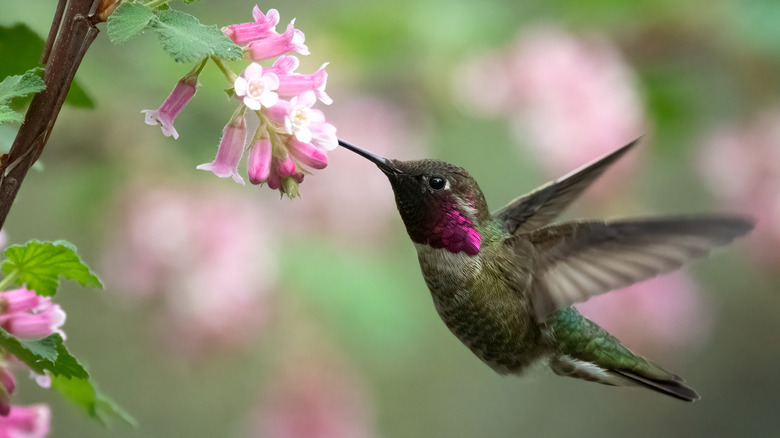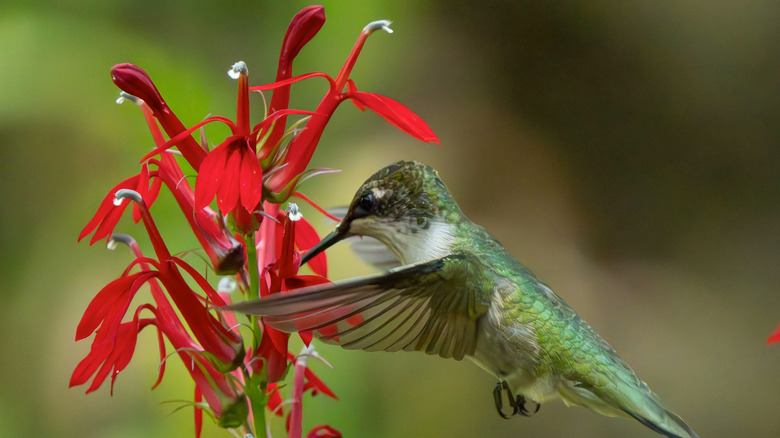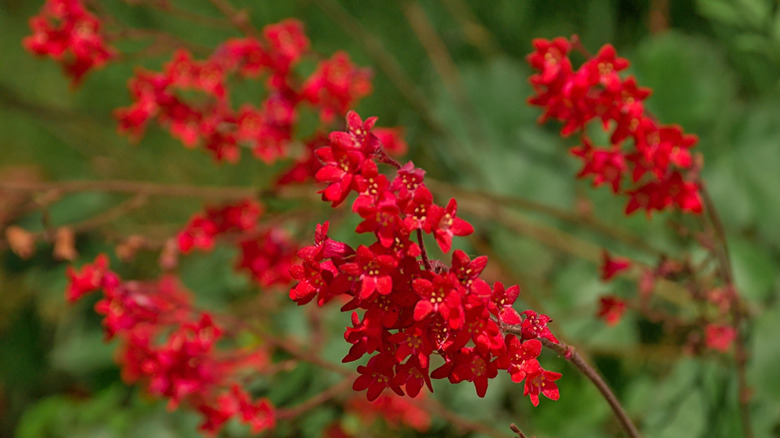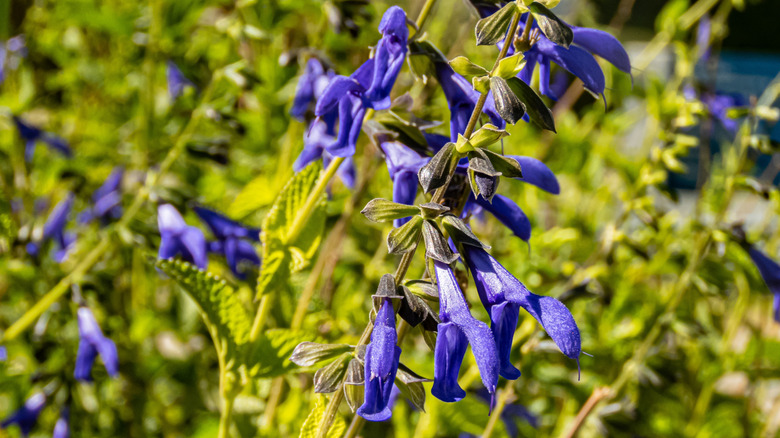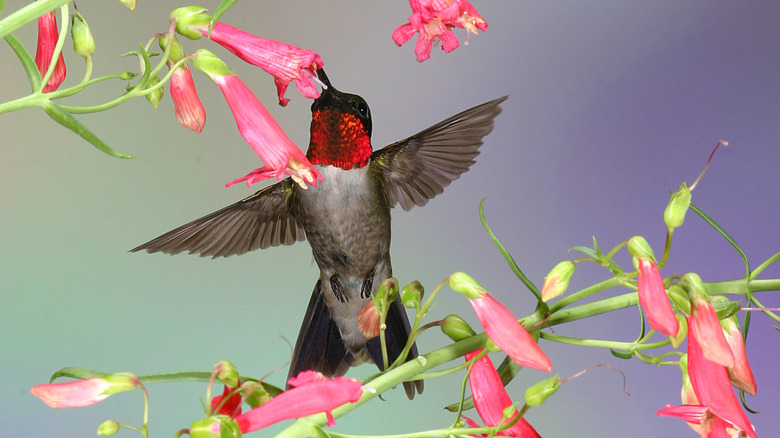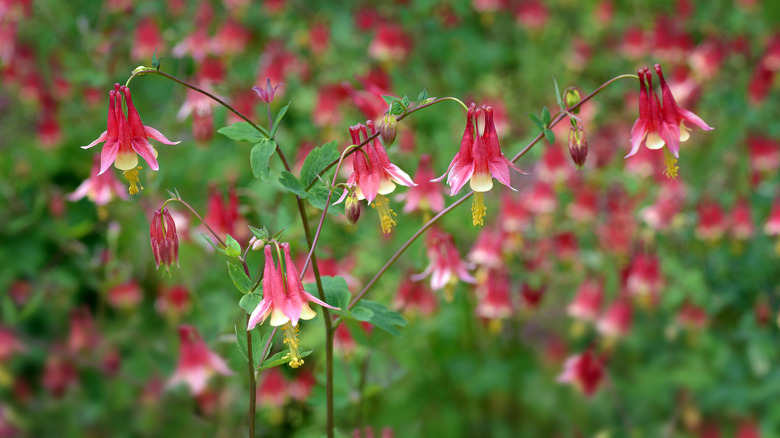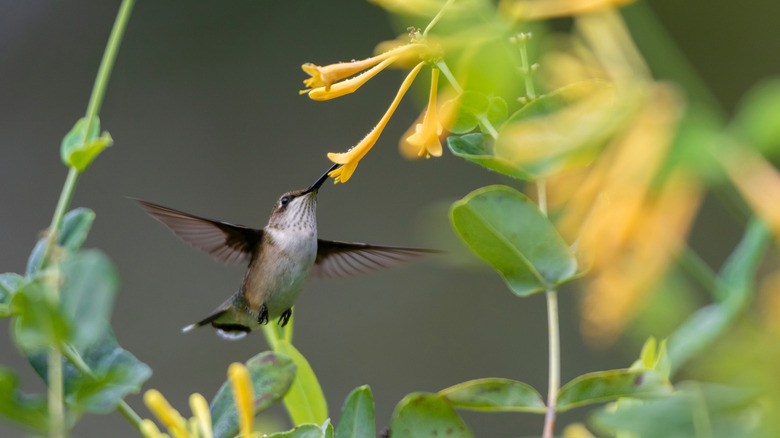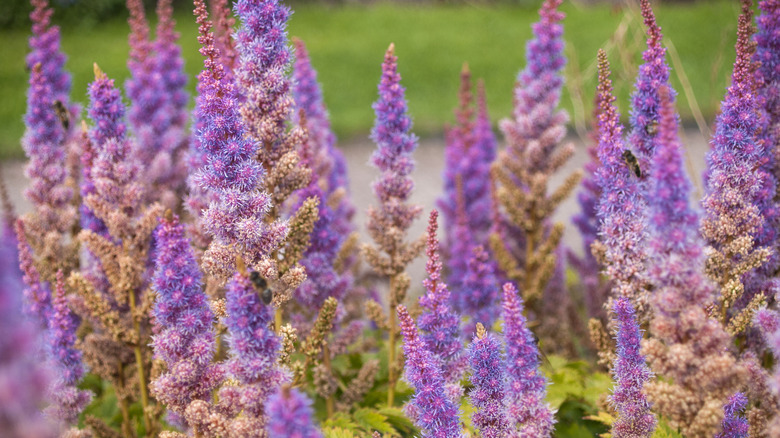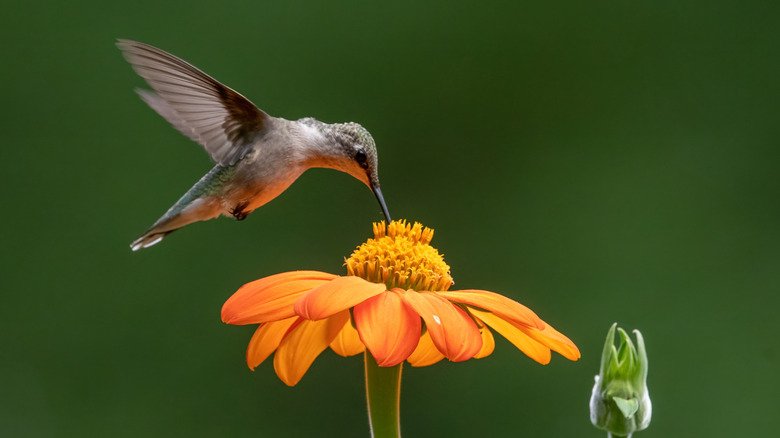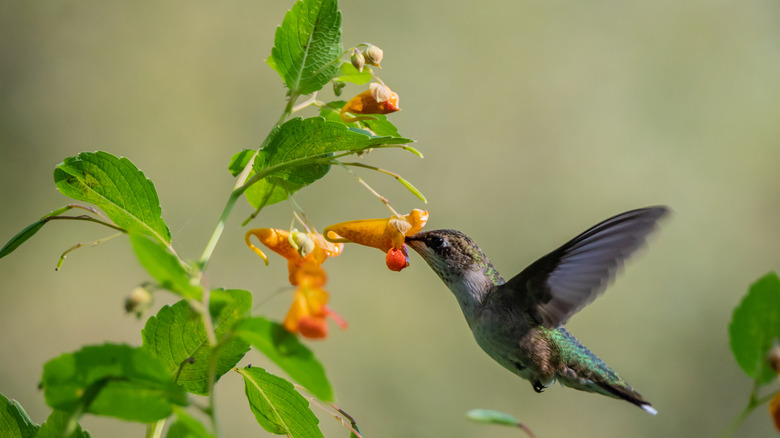10 Flowers That Will Easily Attract Hummingbirds To Your Garden
Hummingbirds need flowers, that goes without saying. From their insect-like hovering abilities to their long, sword-like bills, they're specialty feeders adapted to feed on nectar. But flowers need hummingbirds, too; along with bees and insects, they're crucial pollinators for plants. In fact, some plants have evolved to have colors and shapes that are designed to appeal to hummingbirds, such as long tubes with pollen-bearing stamens positioned to come into contact with the birds as they feed.
To support the rapid movements of their wings, hummingbirds have a very high metabolism, and so they need to consume an immense amount of nectar every day and are always on the lookout for prime feeding grounds. Luring these little jewels into your backyard garden can be as easy as selecting the right flowers. Tubular shapes are often preferred, as hummingbirds' long beaks can function like a key in a lock, and they often gravitate toward flowers in a red, orange, or pink color family. However, these observed preferences don't mean other shapes and colors are off the menu! Before you go making a list of tubular flowering plants in shades of red, try experimenting with different combinations to see what proves to be the biggest draw for your local hummers.
Cardinal flower
Named for the scarlet vestments of Roman Catholic cardinals, cardinal flower (Lobelia cardinalis) is a U.S.-native plant in the bellflower family. This vivid red perennial will grow in USDA Hardiness Zones 3 through 9 as long as the soil is kept moist — it will even tolerate some flooding — so consider using it in a water garden! Cardinal flower can thrive in full or partial sun, though it tends to like some shade in warmer climates, and might need protective mulch applied before cold weather hits to keep its root system safe and healthy. Hummingbirds are crucial pollinators for this self-seeder.
Coral bells
Coral bells (Heuchera sanguinea), boast flowers in shades of saturated pink or red — typically a hummingbird favorite — and attractive heart-shaped leaves that can be evergreen in warmer climates. Considered hardy in zones 3 through 8, this perennial is native to the western part of the United States and likes full or partial sun and high levels of organic matter in its soil; just keep in mind that it is largely intolerant of clay-heavy soils. In colder climates, an application of winter mulch will help protect its roots. Divide this clump-forming plant every three to four years in the spring.
Blue anise sage
It's not only red and orange flowers that can attract hummingbirds, and blue anise sage, or Salvia guaranitica, is a great way to bring a diversity of colors into your pollinator garden. A subshrub native to the southern areas of South America, this deer-resistant shade perennial is typically winter hardy in zones 8 through 10, though the cultivar 'Black and Blue' is particularly tough and can thrive in zone 7 if protective winter mulching is used. If you live in a colder climate, you can still enjoy blue anise sage as a container plant; just fertilize it regularly and bring it inside to overwinter.
Bearded penstemon
For the most part, you can be pretty sure a red or orange tubular flower will be a winner with your local hummingbird population, and bearded penstemon (Penstemon barbatus) is no exception. Native to the southern United States and Mexico, this perennial can thrive in dry soil and is tolerant of drought, making it an ideal choice for your full-sun rock garden in USDA Hardiness Zones 4 through 8. The stems on which blooms appear can grow as high as three feet tall, so try planting it next to lower-growing flowers to create an attractive layered look.
Wild or eastern red columbine
Native perennials are often a great choice for hummingbird gardens, and wild or eastern red columbine (Aquilegia canadensis) is a gorgeous all-rounder with its dangling flowers in a hummingbird-favorite shade of red and foliage that forms attractive ground cover once the blooms have been spent. Considered hardy in zones 3 through 8, red columbine favors shady areas and well-drained soil. Ideal for native pollinator gardens, it is a self-seeder that will naturalize and form colonies all on its own under ideal conditions. Cut flowers are great additions to bouquets, as well.
Beebalm
Fun fact: Monarda didyma gets one of its most commonly used names, beebalm, from the ability of the plant's resin to soothe bee stings. Another common name, Oswego tea, is a nod to an herbal tea made of the leaves, which white settlers learned from indigenous peoples in what is now upstate New York. Hardy in zones 4 through 9, this U.S. native plant enjoys moist to wet soil and full sun. Make sure to leave dead stems standing after you've cut spent flowers, especially if your beebalm is part of a pollinator garden — some native species of bees nest in the dry, hollow stems!
Trumpet honeysuckle
Native to southeastern areas of the United States, trumpet or coral honeysuckle (Lonicera sempervirens) displays eye-catching blooms ranging from crimson to yellow on vigorously-growing vines. The trumpet honeysuckle plant is a great alternative to similar-looking species like the Japanese honeysuckle (Lonicera japonica), which is considered invasive in the U.S. You can encourage trumpet honeysuckle vines to twine around a trellis or fence, or you can allow it to sprawl across the ground. Just keep in mind that it is a highly flammable plant, so maybe consider planting it away from your home if you live in an area with a high wildfire risk.
Purple giant hyssop
A sweet-scented perennial member of the mint family — although thankfully without mint's tendency toward aggressive spreading — purple giant hyssop (Agastache scrophulariifolia) features lovely pale purple tube-shaped flowers on stalks that can grow up to six feet tall. Because it can grow taller and tends to flower longer and later (June through October) than many other pollinator favorites, it can be a great choice for a layered look. Native to many parts of the United States and Canada, purple giant hyssop is hardy in zones 3 through 8 and grows best in moist to wet conditions, thriving in sandy soils.
Mexican sunflower
Another tall selection — up to 6 feet — ideal for the back row of your hummingbird garden, Tithonia rotundifolia, or Mexican sunflower, is a vibrant annual in the aster family that is easy to grow from seed in zones 2 through 11. It thrives in the heat of high summer, preferring full sun and poor, dry soil; in fact, if the soil is too rich, you might just end up with weak foliage and few flowers. A hummingbird attractor when in bloom, Mexican sunflower's spent blooms will also tempt other small birds into your yard to feed from the seedheads.
Jewelweed
Impatiens capensis, or jewelweed, is another U.S. native that, with its uniquely shaped drooping blossoms, seems tailor made for hummers — in fact, it's an important food source for migrating ruby throated hummingbirds. Hardy in zones 2 through 11, jewelweed grows wild in wetter, often wooded areas or on the verge of wetlands, so make sure to give it the dappled sun or shade and moist, humusy soil it needs to thrive. Just keep in mind that it's also called "spotted touch-me-not" for a reason — its seed capsules will literally burst open at the slightest touch and scatter seeds, making it an aggressive self-seeder.
